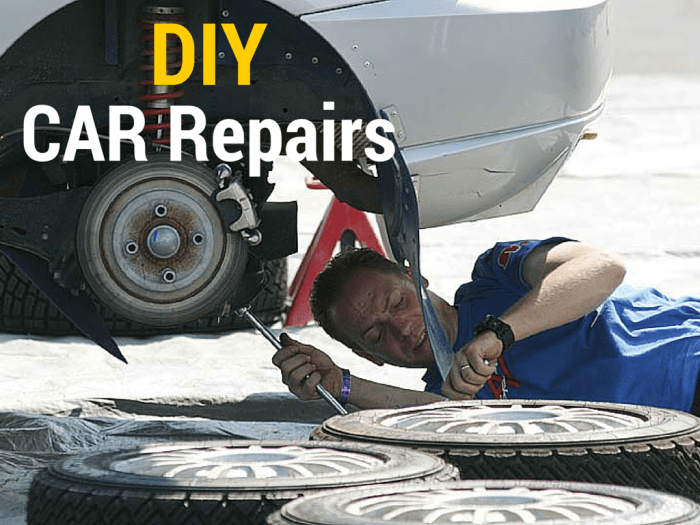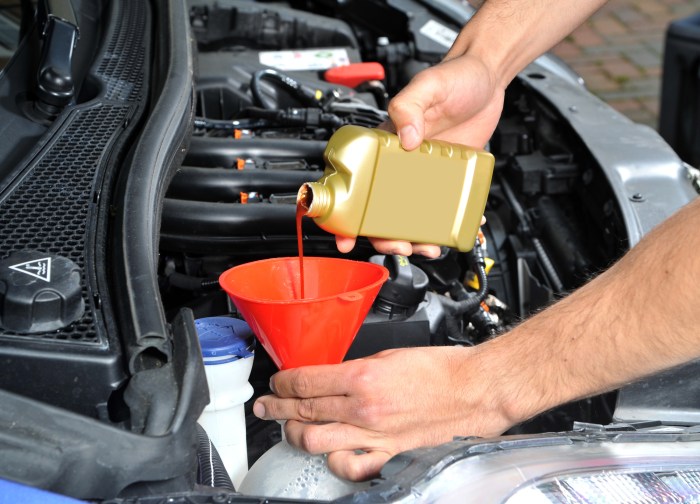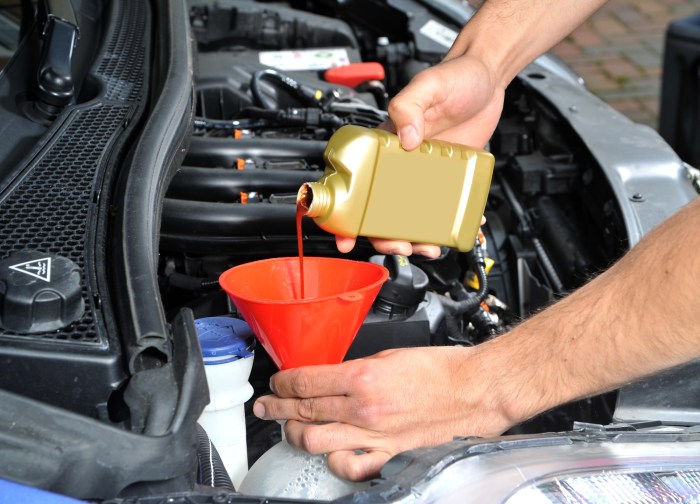DIY car fix is a rewarding experience that offers financial benefits, a sense of accomplishment, and the satisfaction of knowing you can tackle your own car repairs. Whether you’re looking to save money on routine maintenance or simply enjoy the challenge of fixing things yourself, DIY car repair can be a fulfilling endeavor.
The process begins with gathering the right tools and resources. A basic toolkit, a reliable repair manual, and access to online forums can equip you with the necessary knowledge and equipment to tackle a wide range of repairs. From simple oil changes to replacing a car battery, there are many beginner-friendly repairs that you can confidently tackle with the right guidance.
Understanding Car Maintenance Schedules

Regular car maintenance is essential for ensuring your vehicle runs smoothly and lasts longer. By adhering to a maintenance schedule, you can catch potential problems early, preventing major breakdowns and costly repairs.
Car Maintenance Schedules and Associated Tasks
A well-structured maintenance schedule helps you stay on top of your car’s needs. Here’s a general overview of common maintenance tasks and their recommended intervals:
| Task | Interval |
|---|---|
| Oil Change | Every 3,000-5,000 miles or 3-6 months |
| Tire Rotation | Every 5,000-7,500 miles or 6 months |
| Air Filter Replacement | Every 12,000-15,000 miles or 12 months |
| Spark Plug Replacement | Every 30,000-100,000 miles, depending on the type |
| Brake Pad/Shoe Inspection | Every 12,000-15,000 miles or 12 months |
| Fluid Checks (Coolant, Brake Fluid, Power Steering Fluid, Transmission Fluid) | Every 3,000-5,000 miles or 3-6 months |
| Battery Inspection | Every 2-3 years or as needed |
| Timing Belt Replacement (if applicable) | Every 60,000-100,000 miles, depending on the vehicle |
Tracking Car Maintenance Records
Keeping detailed records of your car’s maintenance is crucial for several reasons:
– Ensuring Timely Service: You’ll know when specific tasks are due, preventing potential issues.
– Maintaining Warranty: Some manufacturers require proof of regular maintenance to honor warranties.
– Facilitating Resale: Well-maintained vehicles with documented records command higher resale values.
You can track your maintenance records using a variety of methods:
– Service Manual: Many car manufacturers provide a service manual that Artikels recommended maintenance schedules.
– Digital Apps: Several mobile apps offer features to track car maintenance, set reminders, and store service records.
– Logbook: Maintain a physical logbook to record dates, mileage, and details of each service performed.
It’s always a good idea to keep a copy of your maintenance records in a safe place, such as your glove compartment or a home file.
Identifying and Diagnosing Car Problems
Being able to identify and diagnose car problems is a valuable skill for any car owner. It can help you save money on repairs, prevent potentially dangerous situations, and even extend the life of your vehicle. This section will guide you through the basics of identifying common car problems and provide you with some troubleshooting techniques to help you pinpoint the source of the issue.
Common Car Problem Symptoms and Potential Causes
Understanding common car problem symptoms is crucial for diagnosing the issue. Here’s a list of some frequent symptoms and their potential causes:
- Engine Trouble:
- Rough Idling: This could be caused by a variety of factors, including dirty spark plugs, a faulty fuel injector, a clogged air filter, or a problem with the ignition system.
- Stalling: This can be caused by a number of things, including a faulty fuel pump, a clogged fuel filter, a problem with the ignition system, or a failing battery.
- Loss of Power: This can be caused by a variety of factors, including a clogged air filter, a faulty fuel pump, a problem with the ignition system, or a failing catalytic converter.
- Engine Knocking: This could indicate a problem with the engine’s timing, a failing fuel injector, or a lack of lubrication.
- Engine Overheating: This can be caused by a variety of factors, including a low coolant level, a clogged radiator, a faulty thermostat, or a failing water pump.
- Transmission Problems:
- Slipping Gears: This can be caused by low transmission fluid, a faulty transmission filter, or a failing transmission.
- Grinding Gears: This can be caused by a variety of factors, including worn-out clutch plates, a faulty transmission, or a problem with the gear selector.
- Hard Shifting: This can be caused by low transmission fluid, a faulty transmission filter, or a failing transmission.
- Braking Problems:
- Squealing Brakes: This can be caused by worn-out brake pads or rotors.
- Spongy Brakes: This can be caused by air in the brake lines, a faulty brake master cylinder, or worn-out brake pads or rotors.
- Braking Pulling to One Side: This can be caused by a problem with the brake calipers, brake pads, or rotors.
- Steering Problems:
- Loose Steering: This can be caused by worn-out steering components, such as the steering wheel, tie rods, or ball joints.
- Steering Wheel Vibration: This can be caused by a variety of factors, including worn-out tires, unbalanced wheels, or a problem with the steering components.
- Steering Pulling to One Side: This can be caused by a problem with the steering components, such as the tie rods, ball joints, or wheel alignment.
- Electrical Problems:
- Dim Headlights: This can be caused by a failing battery, a problem with the alternator, or a faulty wiring connection.
- Electrical Short Circuit: This can be caused by a variety of factors, including faulty wiring, a damaged fuse, or a corroded electrical connection.
- Dead Battery: This can be caused by a variety of factors, including a faulty alternator, a problem with the battery itself, or a parasitic drain on the battery.
Basic Troubleshooting Techniques
Once you’ve identified a problem with your car, you can use some basic troubleshooting techniques to try and pinpoint the source of the issue. Here are a few tips:
- Check the Fluids: Make sure all of your car’s fluids are at the correct levels. This includes engine oil, transmission fluid, brake fluid, coolant, and power steering fluid.
- Inspect the Belts and Hoses: Check for any cracks, leaks, or signs of wear on your car’s belts and hoses. These components are essential for keeping your engine running smoothly.
- Check the Air Filter: A dirty air filter can restrict airflow to your engine, leading to a loss of power and poor fuel economy. Replace the air filter if it’s dirty or clogged.
- Listen for Unusual Noises: Pay attention to any unusual noises your car is making. These noises can often be a clue to a problem. For example, a squealing noise could indicate a problem with the brakes, while a knocking noise could indicate a problem with the engine.
- Look for Warning Lights: If your car’s dashboard lights up with a warning light, it’s important to address the issue immediately. Warning lights can indicate a serious problem that needs to be addressed by a mechanic.
Utilizing Diagnostic Tools and Resources
For more complex diagnoses, you may need to utilize diagnostic tools and resources.
- OBD-II Scanners: These devices can be plugged into your car’s diagnostic port to read trouble codes that may be stored in the vehicle’s computer. These codes can provide valuable insights into the source of a problem.
- Online Resources: There are many online resources available to help you diagnose car problems. These resources can provide information on common symptoms, potential causes, and troubleshooting techniques. Some websites even offer free diagnostic services.
- Mechanic’s Manuals: These manuals provide detailed information on how to repair and maintain your car. They can be a valuable resource for diagnosing and troubleshooting problems.
- Professional Mechanics: If you’re unable to diagnose or repair a problem on your own, it’s always best to consult a professional mechanic. They have the experience and expertise to diagnose and repair even the most complex car problems.
Learning from Experienced DIY Mechanics
Learning from experienced DIY mechanics is an invaluable resource for anyone venturing into car repairs. They possess a wealth of knowledge and practical skills that can save you time, money, and frustration.
Online Communities and Forums
Connecting with experienced DIY mechanics online can provide access to a vast network of knowledge and support. These platforms are excellent resources for finding answers to specific questions, troubleshooting problems, and learning from the collective experience of others.
- Car Forums: Dedicated car forums, such as [insert forum name] or [insert forum name], allow users to discuss various car models, share repair experiences, and seek advice from seasoned mechanics.
- Social Media Groups: Many Facebook groups and Reddit communities cater to specific car models or DIY mechanics, providing a platform for sharing knowledge, asking questions, and finding solutions to common car problems.
- Specialized Websites: Websites like [insert website name] or [insert website name] offer forums, articles, and tutorials specifically focused on DIY car repair, connecting individuals with experienced mechanics and providing valuable resources.
Finding and Utilizing DIY Car Repair Videos and Tutorials
With the rise of online video platforms, finding detailed DIY car repair tutorials has become easier than ever. These videos offer step-by-step guidance, visual demonstrations, and expert advice, making it possible to learn new repair techniques and tackle complex projects with confidence.
- YouTube Channels: Channels like [insert channel name] or [insert channel name] provide a wide range of tutorials covering various car models, repair procedures, and maintenance tasks.
- Specialized Platforms: Websites like [insert website name] or [insert website name] focus specifically on DIY car repair videos, offering curated content from experienced mechanics and comprehensive guides on various repair topics.
- Search Engines: Using specific s, such as “[car model] oil change tutorial” or “[car model] brake pad replacement,” can help you find relevant and informative videos tailored to your needs.
Benefits of Seeking Advice from Experienced DIY Mechanics
Seeking advice from experienced DIY mechanics can significantly enhance your car repair journey.
- Avoid Costly Mistakes: Experienced mechanics can guide you through the repair process, preventing costly mistakes and ensuring you use the right tools and techniques.
- Save Time and Money: By leveraging their knowledge and experience, you can avoid unnecessary troubleshooting and repairs, saving both time and money.
- Gain Confidence and Skills: Learning from experienced mechanics provides valuable insights and practical skills that can empower you to handle future car repairs with greater confidence.
- Build a Network: Engaging with experienced mechanics online or in person can help you build a network of knowledgeable individuals who can provide ongoing support and guidance.
When to Seek Professional Help

While DIY car repairs can be rewarding and cost-effective, it’s crucial to understand when your skills reach their limit and professional help is necessary. Attempting repairs beyond your expertise can lead to more significant problems and potentially dangerous situations.
Recognizing When DIY Is Not Enough
Knowing when to call a professional mechanic is crucial for your safety and the longevity of your vehicle. Here are some situations where DIY car repairs are not recommended:
- Complex Electrical Issues: Electrical systems in modern cars are intricate and can be dangerous to work on without proper training. Attempting to diagnose or repair electrical problems without the right knowledge can lead to further damage or even electrocution.
- Engine Overhaul: Engine overhauls involve extensive disassembly, precision work, and specialized tools. Unless you have significant experience and the proper equipment, it’s best to leave this task to professionals.
- Transmission Problems: Transmissions are complex and delicate components that require specialized knowledge and tools. Attempting to repair a transmission yourself can result in irreversible damage.
- Airbag Deployment: Airbags are safety devices that should only be handled by trained professionals. Attempting to repair or replace an airbag yourself can be extremely dangerous.
- Suspension and Steering: These systems are crucial for your vehicle’s safety and handling. If you notice any problems with your suspension or steering, it’s essential to have them inspected and repaired by a qualified mechanic.
Understanding the Risks
Attempting repairs beyond your skill level can lead to various risks, including:
- Further Damage: Improper repairs can worsen existing problems or create new ones, potentially leading to more costly repairs in the long run.
- Safety Hazards: Incorrectly repaired systems, such as brakes or steering, can compromise your safety and put you and others at risk.
- Voiding Warranties: Performing repairs yourself may void your vehicle’s warranty, especially if the repair involves a critical component.
- Increased Costs: In some cases, trying to fix a problem yourself can lead to more expensive repairs when you eventually need to take it to a professional.
The Importance of Professional Assistance
Qualified mechanics have the expertise, tools, and experience to diagnose and repair complex car problems safely and effectively. They can:
- Accurately Diagnose Problems: Mechanics use diagnostic tools and their knowledge to identify the root cause of issues, ensuring the right repairs are made.
- Perform Repairs Correctly: They have the necessary skills and tools to perform repairs to manufacturer specifications, minimizing the risk of further damage.
- Ensure Safety: Professional mechanics understand the safety implications of repairs and will ensure your vehicle is safe to drive after they’re completed.
- Provide Expert Advice: They can offer valuable advice on preventative maintenance, recommended repairs, and the best course of action for your vehicle.
The Future of DIY Car Fixes
The world of automotive technology is rapidly evolving, and with it, the landscape of DIY car repairs is changing dramatically. The rise of sophisticated electronics, connected vehicles, and advanced diagnostics is both exciting and challenging for those who enjoy tinkering under the hood. While the core principles of mechanics remain constant, the tools and knowledge required to tackle modern car problems are becoming increasingly complex.
The Impact of Emerging Technologies, Diy car fix
The future of DIY car repairs is inextricably linked to the advancements in automotive technology. These advancements will impact DIY practices in numerous ways, making some repairs more accessible and others more challenging.
- Increased Use of Electronics: Modern cars are becoming increasingly reliant on sophisticated electronic systems, including engine control units (ECUs), sensors, and actuators. These systems often require specialized tools and knowledge to diagnose and repair, which can be daunting for the average DIY mechanic. However, the availability of affordable and user-friendly diagnostic tools, such as OBD-II scanners, is making it easier for DIYers to identify and troubleshoot electronic issues.
- Connectivity and Data Access: Connected vehicles are generating vast amounts of data about their performance, providing valuable insights for both car manufacturers and DIY mechanics. This data can be accessed through smartphone apps or online platforms, allowing DIYers to monitor their vehicle’s health, diagnose potential problems, and even access repair manuals. This level of access to real-time data is revolutionizing DIY car repairs, making it easier to identify and address problems before they become major issues.
- Advanced Diagnostics and Repair Tools: As cars become more complex, the tools used to diagnose and repair them are also evolving. Specialized diagnostic tools, such as scan tools and oscilloscopes, are becoming more affordable and accessible to DIY mechanics. These tools allow DIYers to perform more sophisticated diagnostics, identify the root cause of problems, and make more informed repair decisions.
While DIY car repairs can be incredibly rewarding, it’s important to recognize when to seek professional help. Complex repairs or those involving specialized tools and knowledge are best left to qualified mechanics. However, with a little research, the right tools, and a commitment to safety, you can confidently tackle a wide range of car repairs and enjoy the satisfaction of fixing things yourself.
DIY car fixes can be a rewarding experience, but sometimes you need a little extra help. Just like a mechanic uses specialized tools, understanding the mechanisms of your body can be crucial for good health. For instance, empagliflozin is a medication that works by affecting how your kidneys handle sugar, which might be helpful for certain health conditions.
Similarly, understanding the workings of your car’s engine can help you troubleshoot problems more effectively.

